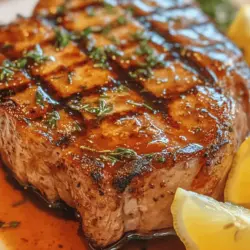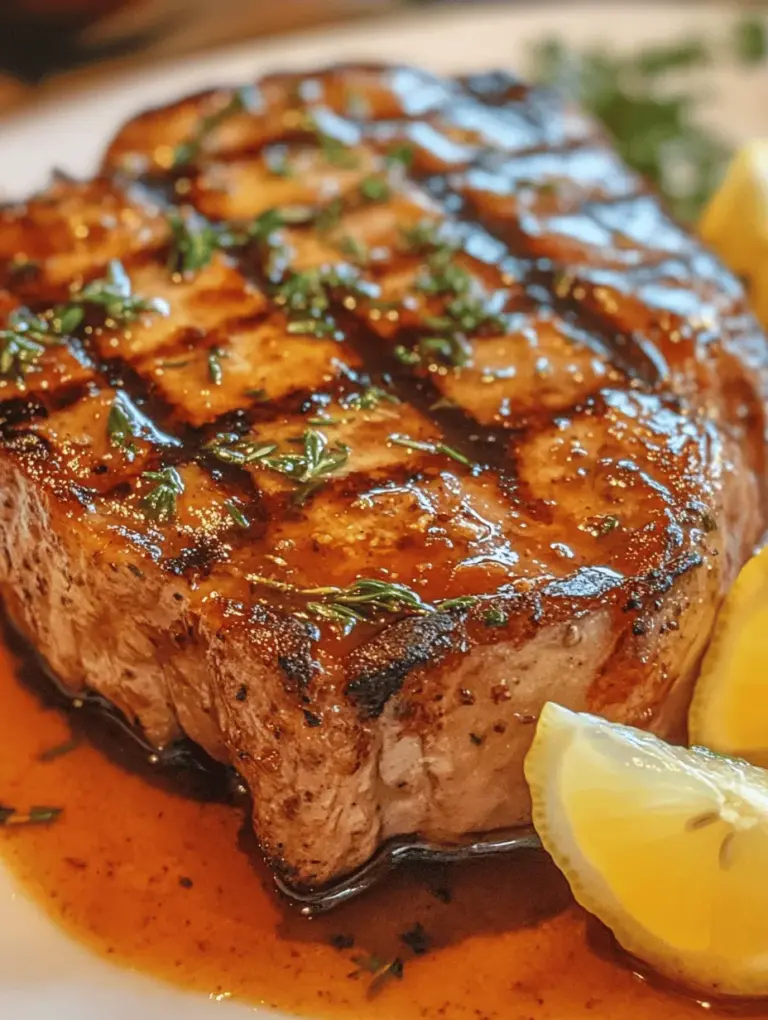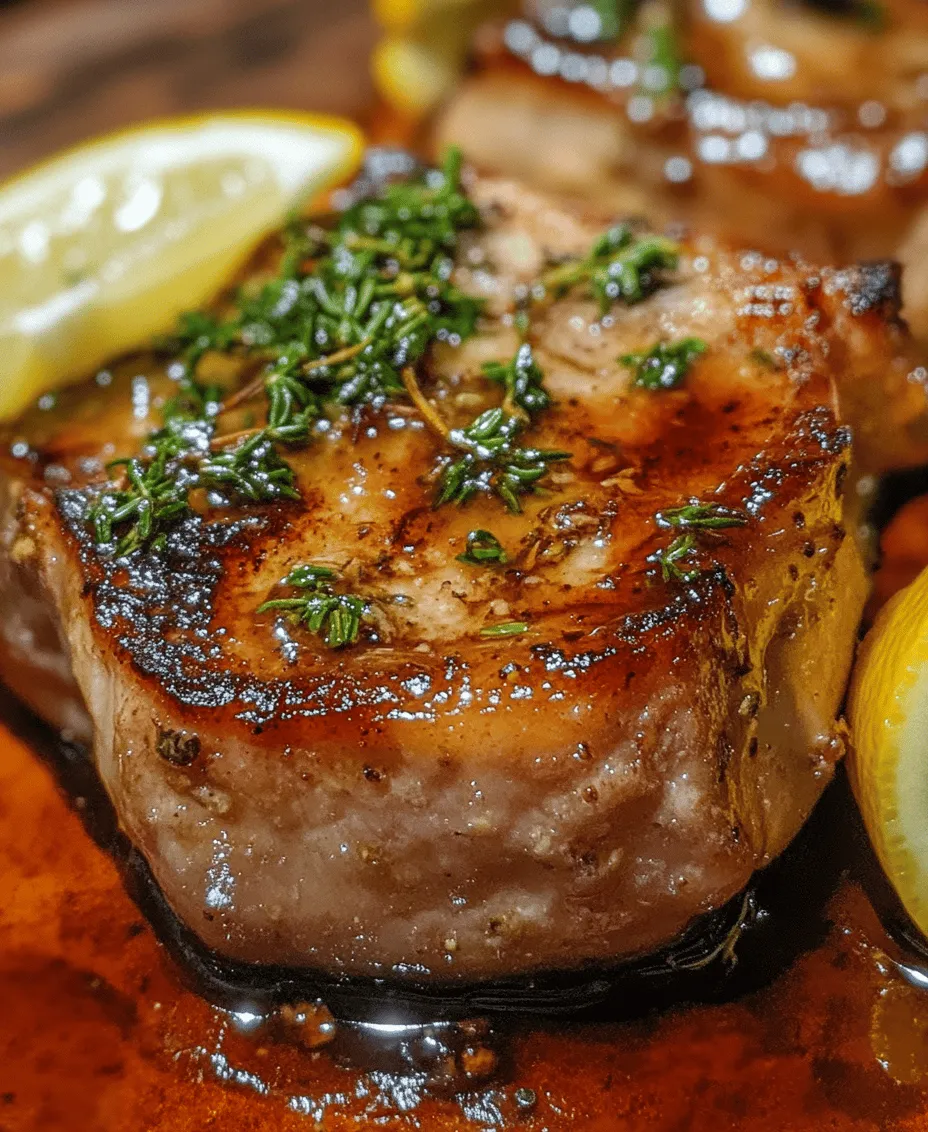Pork chops are often thought of as a simple meal, but when prepared correctly, they can transform into a delightful culinary experience. This “Pork Chops That Melt in Your Mouth” recipe brings out the best in this beloved cut of meat, turning it into a tender dish infused with rich flavors. The appeal of these pork chops lies not only in their melt-in-your-mouth texture but also in their aromatic flavor profile, which combines savory herbs and a hint of sweetness. Whether you’re cooking for a weeknight dinner or a special occasion, this recipe is straightforward and requires minimal effort while delivering maximum taste.
The secret to achieving such tenderness and flavor is rooted in the choice of ingredients and the cooking techniques used. From the selection of bone-in pork chops to the careful balance of seasonings and aromatics, each element plays a critical role in the final dish. Let’s delve deeper into what makes these pork chops so special and how you can easily replicate this mouthwatering meal in your own kitchen.
Understanding the Ingredients
To create pork chops that truly melt in your mouth, it’s essential to understand the key ingredients and their roles in the recipe.
Bone-In Pork Chops
The foundation of this dish is the bone-in pork chop. Choosing the right cut is crucial for achieving that coveted tenderness. Bone-in pork chops tend to be thicker and juicier than their boneless counterparts, as the bone helps retain moisture during cooking. A thickness of at least 1-inch is recommended, as this ensures that the meat cooks evenly without drying out. The bone also adds flavor, making every bite more enjoyable.
Olive Oil and Unsalted Butter
Next, we have olive oil and unsalted butter, which play a dual role in flavor and cooking technique. Olive oil is essential for searing the pork chops, providing a high smoke point that allows for a beautiful golden crust. Unsalted butter, on the other hand, adds richness and a depth of flavor that enhances the overall taste of the dish. The combination of these two fats not only helps with cooking but also creates a luscious sauce that can be drizzled over the finished pork chops.
Garlic, Rosemary, and Thyme
The aromatics in this recipe are what elevate the dish from ordinary to extraordinary. Fresh garlic, rosemary, and thyme contribute an aromatic punch that complements the pork beautifully. Garlic adds a savory depth, while rosemary and thyme provide earthy notes. Fresh herbs are always preferable, but if you only have dried herbs on hand, you can use those as well—just remember that dried herbs are more concentrated, so you’ll need less.
Chicken Broth and Apple Cider Vinegar
Another key element to consider is the liquid base for cooking. Chicken broth provides moisture and additional flavor, while apple cider vinegar adds a tangy brightness that cuts through the richness of the pork. This combination not only helps keep the chops moist while they cook, but it also helps to create a delicious sauce to serve alongside the meat.
Brown Sugar
To balance out the savory and tangy elements, brown sugar is incorporated into the recipe. The sweetness of the brown sugar enhances the natural flavors of the pork and helps create a caramelized crust during the searing process. This touch of sweetness is what makes the flavors pop and brings harmony to the dish.
Seasoning with Salt and Pepper
Lastly, we cannot overlook the importance of seasoning. Salt and pepper are fundamental in any cooking process, as they enhance the natural flavors of the ingredients. For this recipe, it’s essential to season the pork chops generously with salt and freshly cracked pepper before cooking. This not only adds flavor but also helps to create a delicious crust.
Preparation Steps for Perfect Pork Chops
Now that we’ve covered the essential ingredients, let’s discuss the preparation steps necessary to ensure your pork chops turn out perfectly every time.
Preparing the Pork Chops
The first step is to properly prepare your pork chops. Start by removing them from the refrigerator and letting them sit at room temperature for about 30 minutes before cooking. This step allows for more even cooking, as cold meat straight from the fridge can lead to uneven doneness.
Next, pat the pork chops dry with paper towels. This is a crucial step, as moisture on the surface of the meat can inhibit browning, resulting in a less-than-ideal crust. Once dry, season both sides of the pork chops generously with salt and freshly cracked black pepper. For additional flavor, you can also rub some minced garlic and chopped herbs directly onto the meat.
Searing the Chops
Searing the pork chops is where the magic happens. Heat a large skillet over medium-high heat and add a tablespoon of olive oil. Once the oil is shimmering, carefully place the pork chops in the skillet. Avoid overcrowding the pan; if necessary, cook in batches. The goal is to achieve a golden-brown crust, so let the chops sear without moving them for about 4-5 minutes on one side.
After the first side has developed a beautiful crust, flip the chops to the other side. At this point, add a generous pat of unsalted butter to the skillet along with your fresh herbs. As the butter melts, use a spoon to baste the pork chops with the hot butter and herb-infused oil. This technique not only enhances flavor but also helps keep the meat moist.
Creating the Flavor Base
Once both sides of the pork chops are seared and golden brown, it’s time to create the flavor base. Remove the chops from the skillet and set them aside on a plate. In the same skillet, reduce the heat to medium and add minced garlic. Sauté the garlic for about 30 seconds, just until fragrant, being careful not to burn it. Then, deglaze the pan with chicken broth and apple cider vinegar, scraping up any browned bits from the bottom of the skillet. These bits contain a wealth of flavor and should be incorporated into your sauce.
Add a tablespoon of brown sugar to the skillet, stirring until it dissolves completely. This sweet and tangy mixture will form the base of the sauce that you can serve with the pork chops.
Now that you have a solid understanding of the ingredients and preparation steps involved in making pork chops that melt in your mouth, you’re well on your way to mastering this delectable dish. Stay tuned for the next section, where we will explore cooking techniques, additional tips for perfecting your pork chops, and answers to common questions about this recipe.
Mastering the Cooking Process
Cooking pork chops that melt in your mouth is not just about choosing the right cuts of meat; it’s also about technique. Here we’ll explore essential methods to enhance flavor and ensure the perfect texture.
Techniques for Sautéing Garlic and Herbs Effectively
Sautéing garlic and herbs is an art that can elevate your pork chop dish to new heights. To achieve the best results, start with a hot skillet and a good quality oil. Olive oil or butter works well, providing both flavor and a good smoke point.
1. Heat Your Skillet: Preheat your skillet over medium heat. A hot pan ensures that the ingredients get that perfect sear.
2. Add Oil: Once the skillet is hot, add a couple of tablespoons of oil. Let it heat until it shimmers.
3. Introduce Garlic: Add minced garlic to the oil. Sauté for about 30 seconds, stirring constantly to prevent burning. Garlic can turn bitter if overcooked, so keep an eye on it.
4. Add Herbs: Once the garlic is fragrant, add your chopped herbs (such as thyme or rosemary). Sauté them briefly until they release their aroma, usually about 30 seconds. This technique allows the flavors to infuse the oil, which will then coat your pork chops beautifully.
Deglazing the Pan
After sautéing your garlic and herbs, it’s time to deglaze the pan. This technique not only cleans the skillet but also captures all the flavorful bits stuck to the bottom.
– Why is Deglazing Essential?: When you cook meat, it often leaves behind bits of caramelized flavor in the pan. Deglazing helps to lift these bits, creating a rich base for your sauce.
– How to Deglaze: After removing the garlic and herbs, add a splash of liquid such as chicken broth, wine, or even water to the hot skillet. Scrape the bottom of the pan with a wooden spoon to loosen the brown bits. Allow the liquid to reduce slightly, concentrating the flavors.
Cooking the Pork Chops
Now that you have your flavorful base, it’s time to cook the pork chops.
– Simmering and Internal Temperature: Once your pork chops are in the skillet, it’s vital to cook them gently. Use medium to medium-low heat to ensure they cook through without burning. The ideal internal temperature for pork chops is 145°F (63°C). Use a meat thermometer to check doneness accurately.
– How to Check for Doneness: Instead of cutting into the meat, which releases juices and can dry it out, use a meat thermometer. Insert it into the thickest part of the chop, avoiding bones. You’ll know they are done when the thermometer reads 145°F.
Finishing Touches: Resting and Serving
Resting your pork chops is a crucial step that many home cooks overlook.
Importance of Resting the Pork Chops
Resting allows the juices to redistribute throughout the meat. If you cut into the chops immediately after cooking, the juices will flow out, leaving you with dry meat.
– How Long to Rest: Let the pork chops rest for about 5 to 10 minutes under a loose foil tent. This brief resting period enhances the overall juiciness and flavor.
Serving Suggestions
When it comes to serving pork chops, pairing them with the right sides can elevate the meal.
– Pairing with Sides: Mashed potatoes are a classic choice, complementing the richness of the pork. Alternatively, seasonal vegetables like roasted Brussels sprouts or sautéed green beans can add freshness and color to your plate.
– Presentation Tips: To enhance the visual appeal, consider stacking the pork chop on top of a mound of mashed potatoes, drizzling some of the pan sauce over the top. Garnishing with fresh herbs can also add a pop of color and freshness.
Nutritional Information
Understanding the nutritional content of your meal can help you make informed choices.
– Breakdown of Nutritional Content per Serving:
– Calories: Approximately 350 calories per pork chop, depending on preparation.
– Protein: Around 30 grams of protein, making it a great option for muscle repair and growth.
– Fats: About 20 grams of fat, including healthy fats if olive oil is used.
– Carbohydrates: Minimal carbohydrates, especially if paired with low-carb vegetables.
– Health Benefits of Ingredients Used: Pork is a great source of high-quality protein and contains essential nutrients like B vitamins, zinc, and iron. Garlic has been praised for its potential health benefits, including boosting the immune system and reducing blood pressure.
Conclusion
Pork chops that melt in your mouth are not just a delight for the taste buds; they embody the essence of home cooking. With their juicy, tender texture and rich flavor, they can quickly become a family favorite. This recipe is not only simple but also flexible enough to adapt to your taste preferences.
We encourage you to try this recipe for a comforting meal experience that brings warmth and joy to your dining table. The beauty of home-cooked meals lies in their ability to create lasting memories during family gatherings and celebrations. So, roll up your sleeves, gather your ingredients, and enjoy the process of cooking these delicious pork chops. Your family will thank you!



